Please Take Note: This is a review of the game’s final prototype. The art, game bits, and the rules discussed are all subject to change. The game is being reviewed on the components and the rules provided with the understanding that “what you see is not what you might get” when the game is published. If you like what you read and want to learn more, we encourage you to visit the game’s web site or visit the Kickstarter campaign. Now that we have all that disclaimer junk out of the way, on with the review!
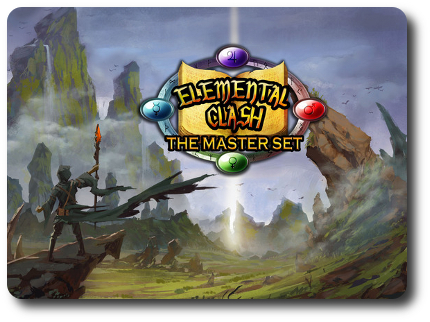
The Basics:
- For ages 8 and up
- For 2 – 4 players
- Approximately 30 minutes to complete
Geek Skills:
- Active Listening & Communication
- Counting & Math
- Logical & Critical Decision Making
- Reading
- Pattern/Color Matching
- Strategy & Tactics
- Risk vs. Reward
- Hand/Resource Management
Learning Curve:
- Child – Moderate
- Adult – Easy
Theme & Narrative:
- Master the elements to master the world!
Endorsements:
- Gamer Geek approved!
- Parent Geek approved!
- Child Geek approved!
Overview
There is a veil that separates reality from endless possibility, and just beyond it lies the power to manipulate and destroy the very powers of creation. Only a handful out of a thousand are sensitive enough to perceive the veil, and from that number a rare few have the ability to focus its power for their own use. These Spellcasters, as they have come to be known, are loved, feared, admired, and hated, but their worse enemies are themselves and their need to dominate all.
Elemental Clash: The Master Set, designed by Andreas Propst and published by Propane Games, LLC, will reportedly be comprised of more than 300 cards, which will include 80 different regular Creatures, Spells and Element-Stone cards, 10 Spellcaster cards, 12 Kickstarter exclusive Promos depicting campaign backers, and up to 8 unique Spell and Creature cards designed by the fans of the game. Our review copy had 286 cards, which included 10 Spellcasters, and a motley assortment of Creature, Spell, and Elemental Stone cards. The game feels exceedingly complete and the artwork and card layout is outstanding. It is also worth noting that Elemental Clash: The Master Set is something of “the best of”, as it includes different cards that originated in prior Elemental Clash card sets. We would also be doing you a great disservice if we didn’t mention that Elemental Clash: The Master Set is a non-collectible card game. This means you buy the game once and you’ve got all the cards. No blind-purchase packs or small boosters are necessary to keep up with the game and other players.
Elemental 101
Elemental Clash is a strategic and tactical card game that let’s the player temporarily take on the role of a powerful Spellcaster that has the ability to part the veil of reality of this world and the next to summon forth incredible creatures and manifest powerful abilities. Here is a brief summary of the different card types in the game that are at the player’s disposal.
Elemental-Stones
“Magic” is the purest form of infinite possibility. It is not made out of nothingness, however. Magic is based on substance that has not yet taken form. Specifically, the elemental building blocks of all things which are Fire, Earth, Water, and Air. But the elements are constantly changing and are easy to manipulate by those who know how. By merging the core elements together, new forms of the elements can be brought into existence. There also exists relics of great power that have the ability to provide the same core elements, but without being specifically aligned.
For a talented Spellcaster, molding and morphing the elements is child’s play, but it takes a great deal of effort to keep them from unraveling back into their primordial forms. As such, the Spellcasters have created the Elemental-Stones. These are elemental powers frozen and locked in a steady state. Through these stones, the Spellcaster can draw forth elements without ever having the need to first mold and focus the elemental power prior to casting a spell. The Elemental-Stone card type is the foundation for all the player hopes to achieve, for it is through them victory can be obtained.
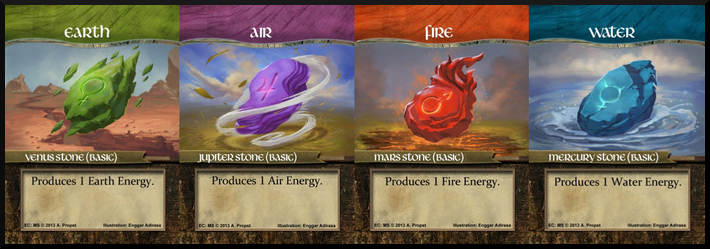
Spells
Spells are formulas that tap the fabric of time and space allowing their user to specifically change reality as needed. Through the use of the Elemental-Stones, the Spellcaster becomes a conduit and focus-point for the spell to manifest. In total, there are three different types of Spells that are available to the would-be Spellcaster. The most common are simply referred to as Spells and the effects of their power are fleeting.
The next type of Spell is referred to as a Flash-Spell that is micro burst of magical energy. They are easy to bring into existence, but because they are formed hastily, their effects are somewhat subdued. Flash-Spells are very useful to a Spellcaster as they can be cast quickly and whenever the situation requires it. Even when the Spellcaster’s foes are busily taking actions of their own.
The last type of Spell is referred to as a Permanent-Spell. As the name suggests, these magical formulas and incantations are so powerful that their effects linger and seem to “stick” to reality. However, these cards must have a constant supply of elemental energy to remain in existence. This means the Spellcaster will have to sacrifice their access to specific Elemental-Stones in order to power their Permanent-Spells.
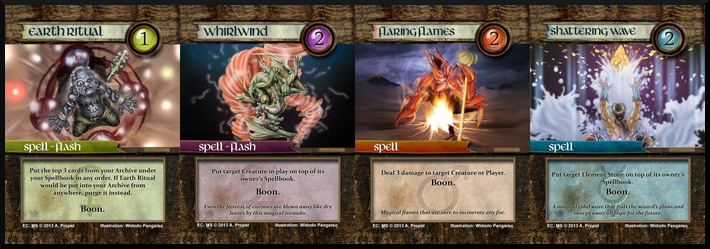
Creatures
Due to the Spellcaster’s ability to tap into and harness the building blocks of reality through the use of the Elemental-Stones, they can create and summon forth creatures to do their bidding. Summoned creatures are loyal and will happily die to protect the Spellcaster or die fighting their foes. But creatures also make excellent shields, and the savvy Spellcaster knows that sometimes the best protection is a giant creature rather than a magical wall.
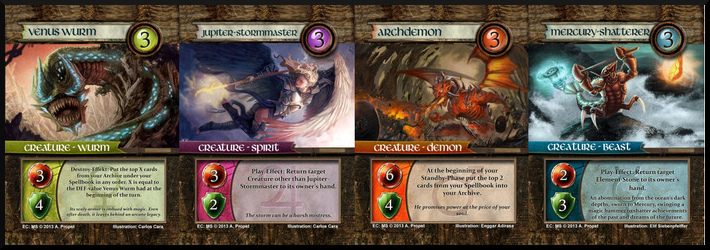
A Word on Deck Building
Before we can even get to the game set up, each player must make a deck using the cards included in the set. The default number of cards is 40 per player; however, if the players use the Spellcasters (further detailed in the Game Variant section of this review), the total number of cards in a starting deck will be different. We suggest that all players ignore the Spellcasters for their first couple of games because they provide a deeper level of complexity.
There is no right or wrong way to create a deck, but part of the challenge is creating a deck that allows the player to win and is fun to play. Theory crafters like to toil away mixing and matching the many different variations and variables in an attempt to create an “unbeatable deck”. Elemental Clash will certainly make the theory crafters think, but the overall game system is simple enough to allow a new player to quickly create their own deck. With only 3 different card types (Elemental-Stones, Spells, and Creatures), a player need only focus on a few key characteristics of their deck to get it going. And because Elemental-Clash is a non-collectible card game, a player has access to all the cards from the very start.
When creating your decks for the first time, we strongly suggest you stick to no more than 2 elements unless you are familiar with deck building games. By sticking to no more than 2 elements, the player can focus more on the Spells and Creatures they will use versus the multiple copies of Elemental-Stones that are needed in order to power their magic. But most importantly, experiment. Mix and match cards and attempt to find just the right level of balance. Every game is an opportunity to learn about how a player’s deck works, both the good and the bad.
Game Set Up
To set up the game, first have all the players shuffle their deck.
Second, decide which player will go first. The first player does not get to draw a card on their starting turn.
Third, each player places their deck to their right-hand side. This deck is referred to as the player’s “Spellbook”. Below the Spellbook will be the player’s “Archive”, which serves as the discard pile. Directly above the Spellbook is “Purgatory”, which is a special discard pile for cards. Each player now draws 7 cards from their Spellbook. These cards should be kept hidden from their opponents at all times. If any player feels they were dealt a bad hand, they can draw a new hand of 7 cards without penalty. Any new hands that are dealt after the second will reduce the player’s hand size by -1.
Fourth, make sure each player has enough room to play the game. In total, the player will need to have enough for 3 rows of cards. A typical playing area will look a little something like the following image.
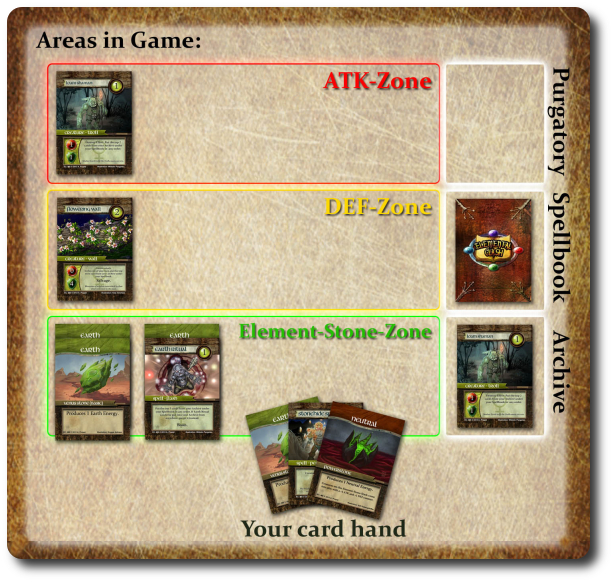
That’s it for game set up. Let’s cast some magic!
Masters of the Elements
The game is played in turns with no set number of turns per game. A player’s turn is comprised of several phases which are summarized here. For more details regarding the game play, please refer to the rule book.
Phase 1: Standby
The first phase of a player’s turn allows them to do some upkeep and shifting of their forces. How they go about that is up to them, but there is an order in which the changes and updates must occur.
- All previously played Creatures are placed in either the Attack or the Defend Zone in front of the player.
- Creatures can be moved from the Attack and Defend Zones freely. The only limitation is that both zones cannot have anymore than 5 Creatures in them.
Phase 2: Draw
The second phase allows the player to draw the top card from their Spellbook deck and place it into their hand. If the player likes, they can then take cards from their hand and place them on the bottom of their Spellbook in any order they like. The player then draws that many cards from the top of the Spellbook. While this is a powerful way to “stack the deck” in the player’s favor, it comes at a cost. By adding and arranging cards in the player’s Spellbook, they forfeit their main phase.
Note that the first player during their first turn skips this phase.
Phase 3: Main
The third phase is the most active and allows the player do several things.
Play 1 Elemental-Stone
The player can now play 1 Elemental-Stone from their hand. Like the Attack and Defend Zones above it, the Elemental-Stone Zone can only hold 5 cards. However, Elemental-Stones stack. When they do, an Elemental-Stone is placed on top of the one below it so that all the card titles below it can be easily seen. A “stack” is considered 1 card. When stacking Elemental-Stones, the total number of elemental power they provide is equal to the number of cards in the stack (most of the time), but the type of elemental power they provide is based on the bottom card of the stack. For example, if a stack of Elemental-Stones had 1 Fire and 3 Water Elemental-Stones, and the bottom card was the Fire Elemental-Stone, the stack would provide 4 Fire elemental energy. There are two exceptions to this rule. If the first card is a neutral Elemental-Stone, the first Elemental-Stone above it will determine the elemental power provided, and in the case where the first Elemental-Stones provide 2 types of elemental power, the player can always choose which they want it to be.

Play Creature and Spell Cards
The player can now play as many Creature and Spell cards as they like and can afford. The cost of a card is noted in the card’s upper right corner. The number indicates the total cost in elemental power it will take to activate the card and the circle in which the number is contained identifies the type of elemental power (by color). For example, the “Necromancy” Spell card below will cost the player 3 Earth (green) elemental power. Note that most cards will cost from 1 to 3, which means a player need create stacks of anymore than 3 cards each, but the number of stacks they can have is set to 5.
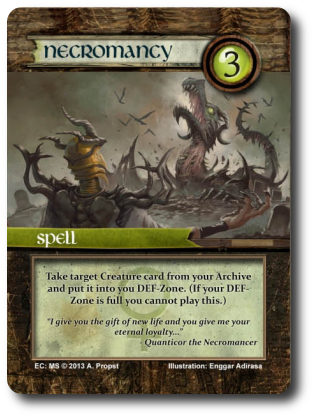
Spell cards are casted as soon as they are paid for, but the Creature cards must remain on the stack until the player’s next turn when they are placed in either the Attack or Defense Zone during phase 1. All Permanent-Spells must remain on a stack to keep their power in play.
The player can also attack with their Creatures during this phase. Any Creature in the Attack Zone can be used to attack a specific Creature in their opponent’s Attack Zone or the player can target their opponent directly. If their opponent doesn’t have any Creatures in their Defense Zone when attacked directly, the damage dealt removes cards from their Spellbook. For example, taking 3 damage would force the opponent to discard the 3 top cards from their Spellbook. If the opponent does have a Creature in their Defense Zone, they can have the Creature intercept the attack on their behalf. This then starts a Creature vs. Creature battle.
When Creatures attack Creatures, they do damage and defend damage simultaneously. This means it is perfectly possible for two Creatures to destroy each other in a single battle. On each Creature card is an Attack value (in a red circle) and a Defense value (in a green circle). For every point in the Creature’s Attack value, their target’s Defense value will be reduced by -1. Once the Creature’s Defense value is 0 or less, they are removed and discarded. Only Creatures in the Attack Zone can be used to initiate an attack and all Creatures “heal” after the player’s turn.
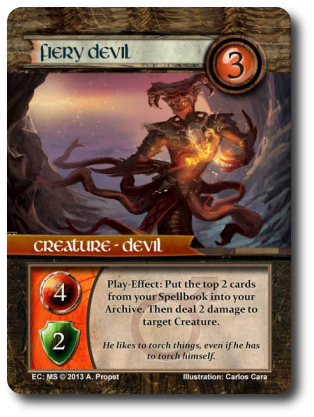
Note that a defending player can have 2 or more Creatures defend against the attack of a single Creature and divide up the damage accordingly between the two defending Creatures as they see fit. Additionally, every Creature can only Attack and Defend once during combat. This means a Creature cannot attack or defend more than once per turn.
Some Creatures have special abilities. The use of these abilities can only be triggered during certain times in the game. For example, the Fiery Devil has a special ability to do 2 additional damage to a target Creature.
Phase 4: End
The final phase ends any effects that lasted until the end of turn and any effects that are triggered at the end of the player’s turn are now triggered, too. Then the player discards down to 7 cards in their hand. This ends the player’s turn. If playing a 2-player game, the next player goes. If playing a 3 to 4-player game, the next player to go is based on the turn order sequence.
Master Over All
In a 2-player game, the battle for elemental supremacy continues until one player can no longer draw cards from their Spellbook with victory going to their opponent. When playing a 3 or 4-player game, the last player who can still draw cards is the winner.
Game Variant
The game comes with a number of Spellcaster cards that can be used during a game to add additional levels of play complexity and enforces new restrictions on the player’s deck. Each Spellcaster card represents a specific and very powerful Spellcaster that the player can temporarily play as during their game. A Spellcaster changes the game play a great deal and is only recommended if players are very familiar with the game.
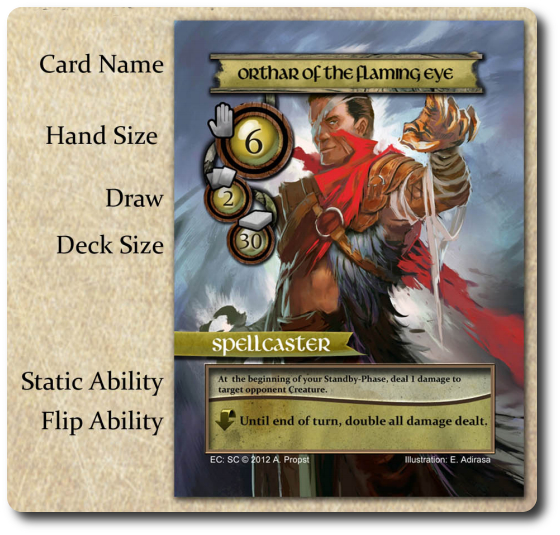
The first thing a player will see is that a Spellcaster changes the number of cards that can be in a player’s deck, how many cards they draw during their turn, and how many cards can be held in the player’s hand in total during the end of their turn. Even more important to note are the Spellcaster’s Static and Flip ability. The Static ability is available to the player for the entire game and for as long as the player has not flipped the Spellcaster over. The Flip ability is a one time special ability that forces the player to flip their Spellcaster over.
The only other game variant rule worth noting is the sidebar. If the player is playing in tournaments or playing tournament-style at their gaming table, they are allowed a sidebar of 10 cards that can be swapped out to change the player’s Spellbook between games.
We’ve glossed over some of the more complex rules of the game for the sake of sanity and highly encourage you to visit the game’s web site or visit the Kickstarter campaign for more details and full rules.
Prediction
We should point out that there are a few cards in the game that might be a bit intense for the younger players. Nothing terribly graphic or violent, but they do depict zombies, skeletons, and demons. These kinds of images, while typical of any fantasy setting, can be worrisome or downright frightening to young and very active imagination. We showed them to our Parent Geeks and Child Geeks (with their parent’s permission) and only 1 out of 4 Child Geeks thought the images were “creepy”. Not that it stopped her from playing…
Predicting how customizable deck-building games will be endorsed is not easy. The player’s overall level of approval will depend not only on their level of understanding of the game, but how well they play with their deck of cards. Since each player will be building their own deck, each player will essentially have their own unique game playing experience.
For the Child Geeks, who we will help when they build their decks, I think Elemental Clash will appeal to the older Child Geeks and will frustrated the younger. While the game play itself is not overly difficulty, there is a lot of strategy and tactics that come into play before the game is even started. Specifically, the deck building aspect. An adult can build a deck for their Child Geeks, but unless the Child Geek is familiar with the cards their deck has and what they do, they’ll be playing blind. Each new card they draw will be brand new to them instead of already being familiar with it. When it comes to games like this, knowing “why” a card is in your deck is just as important as knowing “what” cards are in your deck.
For the Parent Geeks, I think this game will do very well for those Parent Geeks who already enjoy playing Living Card Games and Collectible Card Games with their Child Geeks. I’ll be the first to say that Elemental Clash isn’t breaking a lot of new ground regarding its game play, but the game does introduce and use some unique game mechanism all the same. I think the game will feel familiar and will be accessible, but will also be unique just enough to still keep the player’s interested and guessing.
For the Gamer Geeks, I think Elemental Clash will do well. There are some intriguing deck builds, strategy, and tactics that offer a deep game playing experience. There’s a lot going on in the game and the ability to stack, mix, and match the cards is going to allow the player to come up with some clever combos.
The time needed to teach the game will depend on your player’s gaming background. All the players we introduced the game to were at least familiar with other card-based deck-building games like Pokémon and Magic: The Gathering. A few of our players were familiar with Netrunner and other Living Card Games, too. On average, I found it took at least 15 minutes to explain the game, another 15 to help with the deck-building, and at least 1 game until the player understood what Elemental Clash was all about. After explaining the game and demonstrating a number of the more interesting cards to my 8-year-old, I asked him his thoughts on the game so far.
“Looks great! I can’t wait to create my deck!” ~ Liam (age 8)
His high level of enthusiasm is addictive! Let’s build a deck and play the game to see if we can master its fun or we are left feeling elementally challenged.
Final Word
It took some time, but the Child Geeks ended up really enjoying Elemental Clash. The game didn’t really click or resonate with an individual until they had a friend or two to talk about the game with. From a Child Geek’s perspective, this is the equivalent of group theory crafting. They would get together and look through the cards, make suggestions on how to change their decks, and run through some mock battles. When the social aspect of the game kicked in, the Child Geeks wanted to play it more, talk about it more, and fiddle with it more. Much in the same way they talk about their other card games today. The Child Geeks all voted to approve of Elemental Clash and continue to have a great deal of fun making and breaking decks.
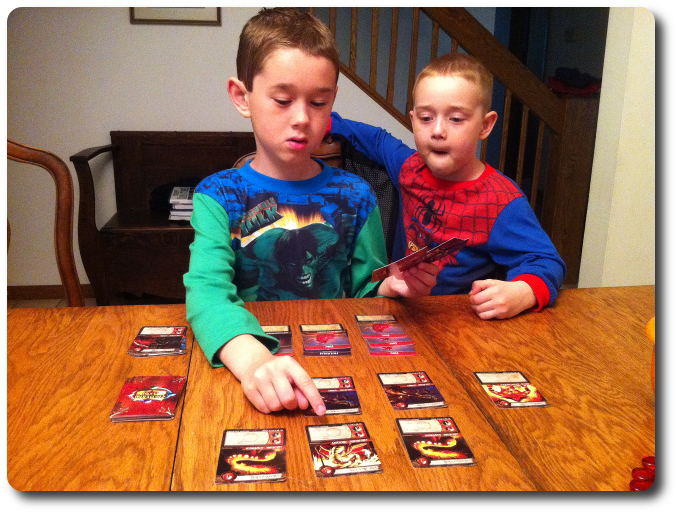
My oldest little geek explains his attack while his younger looks on
The Parent Geeks who enjoyed the game were the ones, as predicted, that played the customizable deck-building games with their Child Geeks. We were unable to find any Parent Geeks who wanted to play the game at a peer level. According to one Parent Geek, “building a deck to fight against my wife doesn’t sound like much fun and could potentially land me on the couch.” But when they did it with their Child Geeks, they had a blast. The Parent Geeks did have some issues with a few of the cards, but any that they really disliked were simply removed from the game without impact to any of the other players or the game play. When the games ended and it came time to collect their endorsements, none of the Parent Geeks hesitated. “Approved!”, they all said with a smile.
The Gamer Geeks also enjoyed themselves and thought Elemental Clash was more complex than casual but not nearly complex enough to be called hardcore. “It’s a perfect blend of tried and true game play with some fun new game mechanisms thrown in. I really like it!”, said one Gamer Geek. The only Gamer Geek who didn’t care for it wasn’t a fan of the sorcery/fantasy theme, but didn’t have anything negative to say about the game or the game play itself. Collectively, the Gamer Geek’s only note of disapproval was the flip side of the Spellcaster. While they appreciated the artwork, they were disappointed that they had to continue to peek at it to see how many cards they got per draw or what their hand-size limit was. They suggested, and I agree, that the information regarding hand-size and card draws should be visible on both sides of the Spellcaster cards.
Elemental Clash: The Master Set is a lot of fun, but a word of caution. This is not a game you can just pour out on the table and play. It takes time to build a really good deck, patience, and willingness to learn from mistakes. And if you are playing with more than 2 players, expect a lot of chaotic battles and some double-teaming. The more casual game player will take one look at this game and say “no thank you”. Not because it’s a bad game, but because the game will take up more of their time than they want. Perfectly reasonable, really. But for everyone else, including the casual customizable deck-builder, Elemental Clash is going to be a winner. It’s a tight game, with excellent rules, outstanding artwork, and fast game play. What I thought would be limiting at first (regarding how many cards that can be played and when), turned out to be nothing more than well-structured and streamlined rules that provided for intense game play. I really enjoyed my time with the game and am most pleased I was able to share it with family and friends. Do take a look at Elemental Clash: The Master Set if you are looking for a fantasy-themed non-collectible customizable deck-building card game.
This game was given to Father Geek as a review copy. Father Geek was not paid, bribed, wined, dined, or threatened in vain hopes of influencing this review. Such is the statuesque and legendary integrity of Father Geek.




Pingback: Elemental Clash: Legendary Legacy Game Expansion Review - Father Geek
Pingback: Elemental Clash: Tribes & Transformations Game Expansion Review – Father Geek